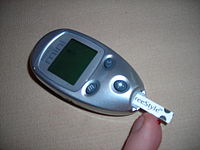
Photo from wikipedia
Abstract Parenteral options for treating neonatal hypoglycemia (NH) include: intramuscular (i.m.) glucagon or intravenous (i.v.) glucose 10%. So far, the role of i.m. glucagon in treating NH has not been… Click to show full abstract
Abstract Parenteral options for treating neonatal hypoglycemia (NH) include: intramuscular (i.m.) glucagon or intravenous (i.v.) glucose 10%. So far, the role of i.m. glucagon in treating NH has not been adequately assessed. We retrospectively studied 236 neonates with NH. One hundred and twenty-one infants received oral glucose-fortified-milk-based formula (OGFM) and their blood glucose level (BGL) was maintained thereafter. Two groups of infants required intervention: (a) OGFM + i.m. glucagon (n = 77, 32.6%) and (b) OGFM + i.v. glucose bolus (n = 38, 16.1%). BGL1, BGL2 and BGL3 denote pre-treatment BGL, 2–2.5 h post-treatment and BGL within 2.5–4 h post-treatment; respectively. The two groups were compared regarding two outcome measures: Outcome no. 1: BGL2 ≥ 45 mg/dL and outcome no. 2: BGL3 ≥ 45 mg/dL. Compared to i.v. glucose, the i.m. glucagon group had significantly more infants with BGL2 ≥ 45 mg/dL (40% vs. 76%, p = 0.028), and marginal significant difference regarding BGL3 ≥ 45 mg/dL (62% vs. 77%, p = 0.08). Univariate analysis showed that i.m. glucagon, male gender, vacuum extraction, cesarean delivery and one or more NH risk factors were significantly associated with outcome measure no. 1. I.m. glucagon, small for gestational age status, cesarean delivery, BGL1 and NH risk factors were associated with outcome measure no. 2. Multi-variate analysis showed that i.m. glucagon was significantly and independently associated with BGL2 ≥ 45 mg/dL. I.m. glucagon is worth consideration as a treatment option for NH.
Journal Title: Journal of Pediatric Endocrinology and Metabolism
Year Published: 2019
Link to full text (if available)
Share on Social Media: Sign Up to like & get
recommendations!